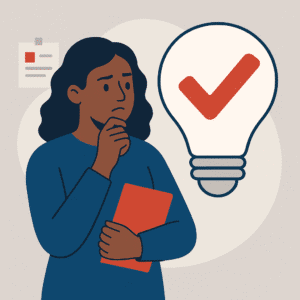Startup Saturdays
Starting a business is exciting—putting a new idea out there, followed by paralysis—“What if it’s the wrong one?” It can be terrifying. Validating a business idea before you build anything helps ease the fear that you’re about to waste your time, your savings, or your last ounce of motivation on something that might not work.
That fear isn’t just theoretical. For me, it was very real. I’ve been in this position more than once. The first time I launched Backbone America, I didn’t validate anything. I thought, “I’ll offer coaching—everyone says I’m good at helping people think things through.” So I signed up for a certification program, bought a bunch of branded pens, business cards, even folders with logos… all before I had a single client. I figured if I just built everything upfront, the results would follow. They didn’t.
And that experience haunted me the second time around. I was scared that history would repeat itself—that I’d pour time and money into a new idea and watch it fizzle.
That’s exactly why validating a business idea became a non-negotiable for me.
Instead of jumping straight into building, I started small. I talked to people. I tested my concepts. I watched closely for reactions. I still do that today with new products: try them out on others, gauge the response, and only then decide if it’s worth the deeper investment.
Validation isn’t about being cautious—it’s about being clear. In this post, I’ll walk you through simple, low-cost ways to test your idea before you build anything. Whether you’re just getting started or thinking about pivoting, this step can save you from wasted energy and help you build with confidence.
Why Validating a Business Idea Matters
When I decided to revive Backbone America, I was filled with hesitation. The truth is, I’d already failed once—or at least, that’s how it felt. The first time around, I threw myself into coaching. I didn’t have a unique perspective, a clear niche, or even a real understanding of what people needed. I just knew I wanted to help.
So I paid for a certification, built a website, printed marketing materials, joined three business groups… and still had no traction. I made decisions with confidence I hadn’t earned yet—financial decisions I later regretted—because I believed the money would come back quickly. It didn’t.
Looking back, I realize the idea itself wasn’t necessarily bad. But I never validated it. I assumed there would be a market. I assumed people would pay. And I assumed that if I looked the part, clients would show up. They didn’t. I didn’t just lose money—I lost momentum, energy, and trust in myself.

It’s not just about financial risk—it’s about emotional risk. When something flops, especially early on, it can shake your confidence in everything that follows. Even great ideas fail when they’re built in isolation.
According to CB Insights, the top two reason startups fail is “failed to raise new capital” and “no market need.” It’s not a lack of talent, drive, or branding—it’s misalignment between what the founder is offering and what the audience actually wants. All of this results in a lack of revenue.
That’s why validating a business idea is so crucial. It’s not about making it perfect. It’s about making sure the problem you’re solving is one people care enough to pay for. Before you build a single thing, you need to know that your idea is grounded in real demand.
The Mindset Shift from “Builder” to “Tester”
When you get a business idea, what’s your first move? For a lot of us (definitely me), it’s to start building. You buy the domain. Order the business cards. Set up your socials and sketch out the logo. You want it to feel real—fast.
I get it. That was me too. On my first try with Backbone America, I did all of that before making a single sale. I had branded pens, folders, notepads—two versions of business cards with two addresses I didn’t end up keeping. I joined professional organizations and paid for networking events. I thought if I just acted like a business, the money would follow. It didn’t. At least not fast enough to justify the time and money I’d already spent.
And if I’m honest, I still have to fight that instinct. I’m a planner. I’m action-oriented. Which means even now, I have to resist the urge to build first and validate later.
What I’ve learned is that validating a business idea isn’t just a checkbox—it’s a shift in how you think. It means moving from builder to tester. From “how do I make this look legit?” to “how do I know this solves a real problem?”
Less polish. More listening. Less output. More observation.
When I relaunched Backbone America, I did it differently. I asked better questions. I tested smaller pieces. I shared rough ideas and gauged the reaction before investing more. And what I saw confirmed it: the audience doesn’t care about your font choices—they care about whether your offer helps them.
Validation doesn’t start with a logo. It starts with clarity. What pain point are you solving—and who actually wants that solved? Until you have that, nothing else matters.
3 Questions to Validate Before You Build
Validating a business idea doesn’t mean you have to run a full-blown test or invest in complicated research. It starts by asking the right questions—and being willing to slow down long enough to listen to the answers. This isn’t a checklist to rush through. It’s a way to get honest about whether your idea actually has traction before you commit time and money to building it out.
Here are three questions I now ask every single time I consider launching something new:
1. Does this solve a real, urgent problem?

You don’t need thousands of data points to figure this out. Sometimes, five honest conversations can tell you more than a paid survey. What questions are people already asking? What are they struggling with? What’s showing up in your DMs, comments, or emails?
That’s exactly how the 31-Day Business Startup Challenge came to be. I kept hearing from people who wanted to start a business—but they didn’t know where to begin, what to focus on, or how to fit it into their already full lives.
The real problem wasn’t a lack of ambition—it was a lack of structure. So I built a program that answered that pain point step by step, and I tested it by releasing pieces slowly, watching what people responded to, and refining it along the way.
If you’re not sure what pain points your audience is facing, spend a few minutes on Quora or Reddit. They’re treasure troves of raw, unfiltered questions from real people looking for solutions. Pay attention to the posts that get lots of engagement—that’s where the pain is.
2. Are people already searching for or spending on this?
There’s a difference between a cool idea and a viable business. One of the easiest ways to validate a business idea is to see if people are already searching for solutions. Tools like Google Trends can show you whether there’s demand—and what language people are using.
If there’s already competition, don’t panic. That’s actually a good sign. It means people are spending money in this space. Your job is to find your angle.
In the 31-Day Business Startup Challenge, we don’t start with branding or a dream board—we start by helping you get clear on what kind of business fits your life and whether there’s a real need for it. You’ll explore your strengths, test your assumptions, and outline your idea in a way that connects with what your audience is already asking for.
3. Will your target buyer say yes with their time, money, or data?

The first time I offered coaching, I assumed people would pay just because I had expertise. I followed coaches who looked successful and figured, “That’ll be me.” But I didn’t test the offer. I didn’t ask for feedback. I didn’t even check if people wanted to pay for what I was offering. I mistook other people’s results for market proof—and that was a hard lesson.
Now, I test interest small experiments before launching anything big. A lead magnet. A waitlist. A quick mini-offer. If people bite, I know I’m on the right track. If they don’t, I don’t take it personally—I take it as data.
Common Pitfalls to Avoid
Even when you know validating a business idea is important, it’s easy to slip into patterns that feel productive but don’t actually move you forward. Here are a few traps I’ve fallen into—and what I’ve learned to look out for:
Building too much too soon
It’s tempting to go all-in from day one. Courses, websites, full-blown product suites. But building before you have an audience—or even a single confirmed buyer—is a fast way to burn out. It’s not just about the money spent. It’s about the time you can’t get back. I’ve learned (the hard way) that your first version doesn’t need to be fully built. It needs to be tested.
Taking silence as approval
It’s easy to think that if no one pushes back, your idea must be solid. But silence isn’t the same as validation. If you share your idea and don’t hear much in return—no questions, no curiosity, no follow-up—that’s not quiet support. It might mean the idea didn’t land. Or that it didn’t seem urgent enough to care about.
If that happens, don’t take it personally—but don’t ignore it either. Use it as a sign to revisit the way you’re framing the problem. Is it clear enough? Is it specific enough? Are you talking to the right people? Sometimes the problem is real, but the way it’s being presented isn’t resonating yet.
Confusing compliments with real interest
People will be kind. Too kind, sometimes. They’ll tell you your idea is “great” or “really needed” just to be supportive. That doesn’t mean they’d pay for it—or even sign up if it were free. I’ve learned to listen for hesitation. I watch what people do, not just what they say. Enthusiasm without action isn’t validation.
Avoiding these traps doesn’t guarantee your idea will work—but it helps you stay grounded, clear-eyed, and responsive. And that mindset is just as important as the strategy itself.
What Validation Looks Like in Real Life

Here are a few simple examples of what validating a business idea can look like, even in the earliest stages:
→ A service-based business testing a concept with a mini audit or form
Let’s say you’re thinking about offering virtual CFO services. Instead of building a full program, you create a short “Financial Clarity Checkup” and offer it for free or low-cost. If people sign up, ask questions, or share the offer with others, you’re not just getting visibility—you’re confirming there’s demand.
→ A digital product validated with a lead magnet or early access list
Maybe you want to launch a course. Instead of building the whole thing, you put together a lead magnet like a guide or workbook. If people download it and stick around for more, that’s a green light. Want to go further? Invite them to join a waitlist or vote on topics—that’s actionable feedback and interest.
→ A physical product tested with prototypes or pre-orders
If you’re designing a product—say, custom planners for business owners—don’t wait until you’ve ordered inventory. Share a digital mockup. Ask for feedback. Offer a preorder discount to the first 10 people who commit. The response will tell you whether the idea resonates before you invest in production.
What to Do After You Validate
So you’ve put your idea out there. You’ve tested it, listened, and gathered real feedback. Now what?
If the response is positive—keep going, but stay lean.
Validation means you’ve struck a chord, not that it’s time to go all-in overnight. Build the next layer. Maybe that’s a beta version of your offer. Maybe it’s a paid trial or a pilot group. Use what you’ve learned to refine the offer, test your pricing, and keep listening as you grow. You’re not locking yourself into a final product—you’re deepening your understanding of what works.
And here’s the key: stay close to your audience. The clearer the communication, the easier it is to evolve your idea without drifting off course.
If the response is underwhelming—pause, reflect, and regroup.
This isn’t failure. It’s clarity.
Sometimes an idea doesn’t land the way you hoped. That doesn’t mean you have to scrap it entirely—but it might mean the positioning, pricing, or audience needs to shift. Go back to the pain point. Ask follow-up questions. Was it the timing? The framing? Or was it something that matters to you, but not enough to someone else?
When I’ve had offers flop, I remind myself: better to learn now than later. I’d rather course-correct early than scale something no one really wants.
Validation is the beginning of clarity—not the end of it. Whether your idea hits right away or takes a few tries, what matters is that you’re listening, adjusting, and staying focused on solving a real problem for a real person.
Final Thoughts on Validating a Business Idea
Validating a business idea before you build anything isn’t about playing it safe—it’s about working smarter. It protects your energy, your time, and your confidence. It keeps you from pouring your best effort into something that doesn’t have a clear destination yet.
The reality is: no one hands you a certificate and says, “This is the right idea—go build it.” You have to figure that out by paying attention to how your audience responds. Not with praise, but with action.

If you want more guidance on how to take those steps in a structured way, I created the 31-Day Business Startup Challenge for exactly that reason. It walks you through how to shape your idea, find your footing, and launch with intention—not guesswork.
You don’t have to have it all figured out. But you do have to start. And validation is the best place to begin.






